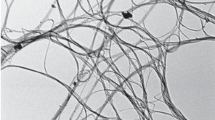Abstract
The relationship between synthesis conditions, structure, and properties of the baddeleyite-based engineering nanostructured composite zirconia ceramic (natural zirconia mineral) with modifying alloying elements is studied. The elaborated composites possess high physical and mechanical properties at a level that is not only not inferior, but even superior to those of analogous ceramics prepared from precipitated zirconia (e.g., density is 0.95 of the theoretical value, the hardness reaches 12 GPa, the Young modulus is 220 ± 15 GPa, and the fracture toughness reaches 9 MPa m0.5). The embedding of carbon nanotubes (CNTs) is shown to alter the physical and mechanical properties of ceramics: the hardness is somewhat reduced, but fracture toughness KC gains more than 10%.
Similar content being viewed by others
References
B. Basu and K. Balani, Advanced Structural Ceramics (Wiley, Hoboken, NJ, 2011).
J. F. Bartolome, A. H. de Aza, J. Y. Pastor, J. Llorca, R. Torrecillas, and G. Bruno, “Alumina/zirconia micro/nanocomposites: a new material for biomedical applications with superior sliding wear resistance,” J. Am. Ceram. Soc. 90, 3177–3184 (2007).
P. Palmero, “Structural ceramic nanocomposites: a review of properties and powders synthesis methods,” Nanomaterials, No. 5, 656–696 (2015).
A. O. Zhigachev, A. V. Umrikhin, and Yu. I. Golovin, “The effect of calcia content on phase composition and mechanical properties of Ca-TZP prepared by highenergy milling of baddeleyite,” Ceram. Int. 41, 13804–13809 (2015).
C. Suryanarayana, “Mechanical alloying and milling,” Prog. Mater. Sci. 46, 1–184 (2001).
A. O. Zhigachev, A. V. Umrikhin, Yu. I. Golovin, and B. Ya. Farber, “Preparation of nanocrystalline calciastabilized tetragonal zirconia by high-energy milling of baddeleyite,” Int. J. Appl. Ceram. Technol. 12, E82–E89 (2015).
W. Xue, Z. Xie, J. Yi, and C. A. Wang, “Spark plasma sintering and characterization of 2Y-TZP ceramics,” Ceram. Int. 41, 4829–4835 (2015).
M. H. Bocanegra-Bernal, C. Dominguez-Rios, J. Echeberria, A. Reyes-Rojas, A. Garcia-Reyes, and A. Aguilar-Elguezabal, “Spark plasma sintering of multi-, single/double- and single-walled carbon nanotube-reinforced alumina composites: is it justifiable the effort to reinforce them?,” Ceram. Int. 42, 2054–2062 (2016).
V. T. Kalinnikov, V. R. Lebedev, E. P. Lokshin, V. P. Lyakhov, and V. F. Popovich, “The technology of obtaining zirconium dioxide of special purity from baddeleyite concentrate of kovdor mining and processing plant,” in Physicochemical Problems of New Construction Ceramic Materials Creation (Syktyvkar, 2002), pp. 227–232 [in Russian].
K. Lu, “Sintering of nanoceramics,” Int. Mater. Rev. 53, 21–38 (2008).
A. O. Zhigachev and Yu. I. Golovin, “Nanostructured zirconia ceramic based on baddeleyite domestic raw,” Nanotechnol. Russ. 12, 400–408 (2017).
C. A. Cooper, R. J. Young, and M. Halsal, “Investigation into the deformation of carbon nanotubes and their composites through the use of Raman spectroscopy,” Composites, Part A 32, 401–411 (2001).
Yu. I. Golovin, “Nanoindentation and mechanical properties of solids in submicrovolumes, thin near-surface layers and films: review,” Phys. Solid State 50, 2205–2236 (2008).
J. Alcala, “Instrumented micro-indentation of zirconia ceramics,” J. Am. Ceram. Soc. 83, 1977–1984 (2000).
N. A. Fedosova, E. M. Kol’tsova, N. A. Popova, E. V. Zharikov, and E. C. Lukin, “Ceramic matrix composites reinforced with carbon nanotubes: spark plasma sintering, modeling, optimization,” Refract. Ind. Ceram. 56, 636–640 (2016).
Author information
Authors and Affiliations
Corresponding author
Additional information
Original Russian Text © Yu.I. Golovin, A.I. Tyurin, V.V. Korenkov, V.V. Rodaev, A.O. Zhigachev, A.V. Umrikhin, T.S. Pirozhkova, S.S. Razlivalova, 2018, published in Rossiiskie Nanotekhnologii, 2018, Vol. 13, Nos. 3–4.
Rights and permissions
About this article
Cite this article
Golovin, Y.I., Tyurin, A.I., Korenkov, V.V. et al. Effect of Carbon Nanotubes on Strength Characteristics of Nanostructured Ceramic Composites for Biomedicine. Nanotechnol Russia 13, 168–172 (2018). https://doi.org/10.1134/S1995078018020039
Received:
Accepted:
Published:
Issue Date:
DOI: https://doi.org/10.1134/S1995078018020039




